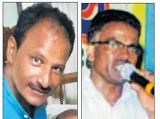Pandavapura (Mandya dist), Apr 14: Two schoolteachers clicked the SSLC?Hindi (third-language) question paper the moment it arrived at an examination centre in Pandavapura town on Wednesday morning, shared it on WhatsApp, printed it out and started selling it to students.
 Shambunahalli Manjunath, a teacher at Jnana Bandhu School, and Manjunath, a physical education teacher at Vijaya High School, were among the first to get the paper when it arrived at Vijaya College of Education, some time after 9 am. They quickly clicked its pictures on their mobile phones and rushed to the office of a civil engineer where they printed it out.
Shambunahalli Manjunath, a teacher at Jnana Bandhu School, and Manjunath, a physical education teacher at Vijaya High School, were among the first to get the paper when it arrived at Vijaya College of Education, some time after 9 am. They quickly clicked its pictures on their mobile phones and rushed to the office of a civil engineer where they printed it out.
But police got wind of the matter in the nick of time and raided the office.
They found that the paper was circulated on WhatsApp before making its way to the office of K Purushottam, the civil engineer. The printouts of the Hindi paper were found on the table. A laptop had soft copies of not just Hindi paper, but also Kannada, Social Science, Science and Mathematics papers. The police caught Purushottam and Nanjundaswamy, a teacher at a government primary school. But Shambunahalli Manjunath, Manjunath and an unidentified man fled the spot.
Pandavapura Block Education Officer B Chandrashekar claimed that the papers were sent to the exam centres only at 9.15 am. The seal was opened in the presence of supervisors and distributed to students at 9.30 am. “Despite this, it's shocking that the paper was leaked,” he said.
Shivamadappa M, DDPI, Mandya, confirmed that the paper that was leaked was original. “The police caught some people trying to photocopy the paper. It was a scanned copy of the original paper circulated on WhatsApp. They were caught printing the papers at 9.30 am,” he said.





Comments
this is better than teachers kissing students
Add new comment